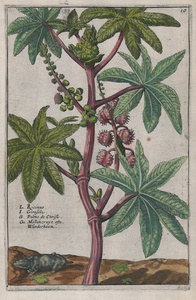| Method | Copper engraving with hand colouring |
| Artist | Crispijn van de Passe the Younger |
| Published | Utrecht & Arnheim: Crispen de Passe and J. Jansson, 1614-1616. |
| Dimensions | Image and plate 218 x 142 mm, Sheet 274 x 185 mm |
| Notes |
A plate depicting a Castor Oil plant from Hortus Floridus in quo rariorum & minus vulgarium florum Icones ad vivum veramque accuratissime delineatae... A Garden of Flowers, wherein very lively is contained a true and perfect discription of all the flowers contained in these foure followinge bookes... Faithfully and truely translated out of the Netherlandish originall into English. This book was one of the most famous and influential of the early florilegia. Produced against the back drop of the early tulip and bulb craze of the early 1600, the book gained tremendous popularity and also helped to fuel the craze for these new plants. The delicate copper engravings showed the flowers much better than earlier wood cut prints. The frontis piece to this work tells the owner that he should colour the prints in himself. Crispijn van de Passe the younger (c.1594 – 1670) was a Dutch Golden Age artist, engraver, and publisher. The son of Crispijn de Passe the Elder, de Passe the Younger was born in Cologne. He spent much time in Paris, where he worked on Pluvinal's 'Maneige Royal', returning to Utrecht in 1629. After his father's death in 1637, he moved to Amsterdam taking the family firm with him. From the 1640s he increasingly became interested in publishing broadsides and in 1665 he was questioned by the government for the pro-Orange broadside 'Sinne-Beeld.Ter eeren van Sijn Doorluchtighste Hoogheyt Wilhem de III. Prins van Oranjen'. de Passe found little success as an engraver in Amsterdam and died in poverty. Condition: Spot of foxing to right of image. Ink stain to top of sheet. |
| Framing | mounted |
| Price | £175.00 |
| Stock ID | 51896 |

